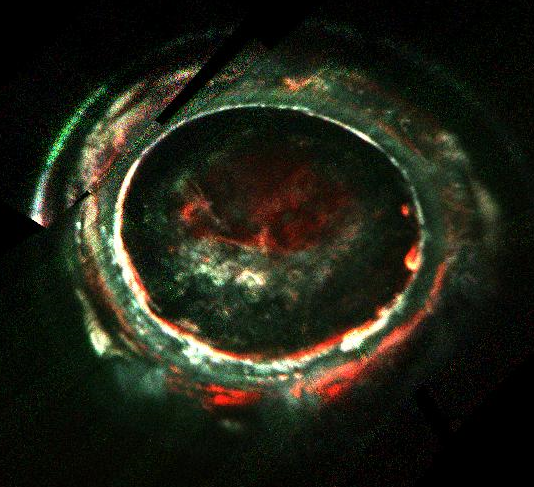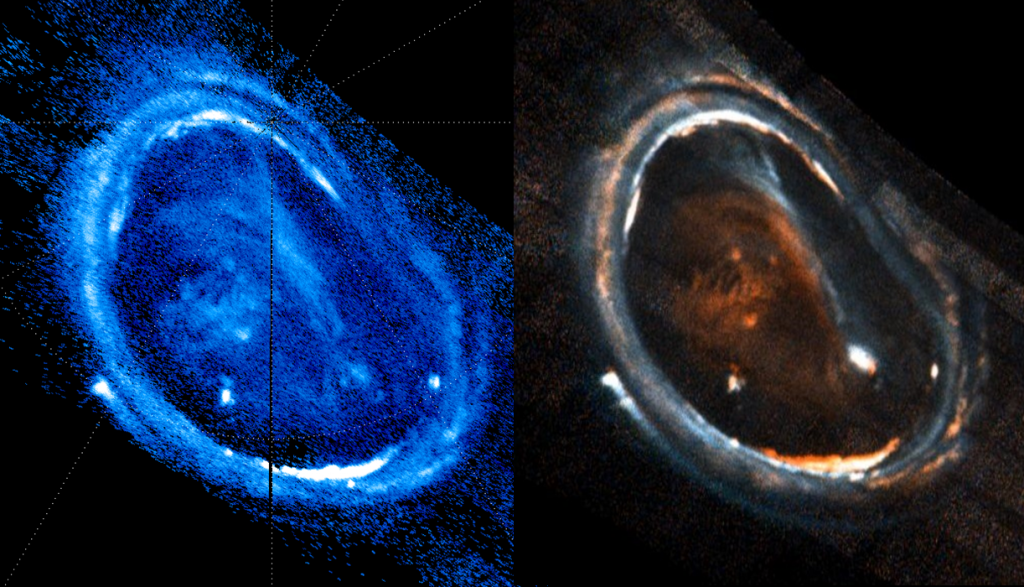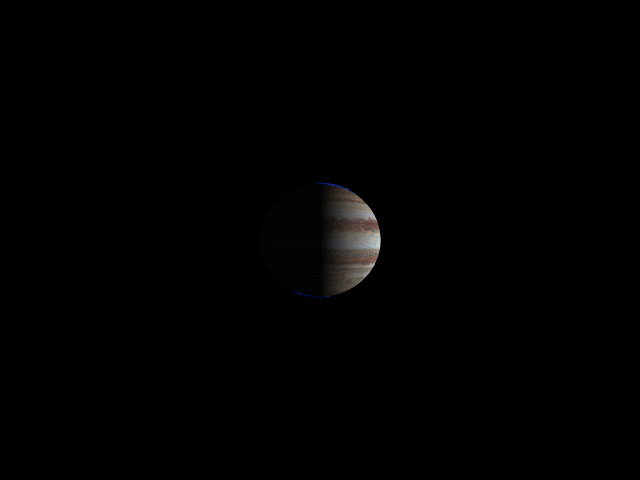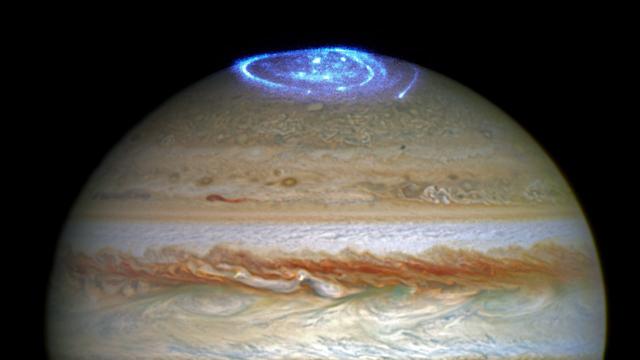Jupiter features the largest and most powerful auroral display in the Solar System. As spectacular as they are, however, very little is known about these dancing displays of Southern and Northern lights. A recent survey by NASA’s Juno spacecraft is providing new evidence about Jupiter’s auroras — and it’s becoming increasingly clear they’re not at all like what we expected.
Image: Hubble Space Telescope
New research published in Nature is dramatically expanding — and altering — our understanding of how Jupiter’s auroras work. Prior to the new study, scientists assumed that the Jovian Southern and Northern Lights operate according to the same processes that produce strong aurora on Earth, but new data from Juno suggests this isn’t the case. Unlike our planet, where polar aurora are triggered by accelerating electrons, the ones on Jupiter are sparked by electrons trapped in the planet’s enormous magnetic field. The new study raises as many questions as it answers, but scientists are finally starting to get a grip on the complex processes that produce aurora on gas giants.

Aurora at Jupiter’s southern pole, as seen by Juno. The colours represent different wavelength strengths of electrons hitting the atmosphere, where red is high, and blue is low. That weird auroral streak at top left is caused by Jupiter’s moon Io. (Image: G. Randy Gladstone)
“For decades our understanding of Jupiter’s auroral emissions had relied almost entirely on remote observations, like images taken with the Hubble Space Telescope, and theoretical arguments, which are based on studies of the Earth’s aurora,” said Marissa Vogt, an NSF postdoctoral fellow in the BU Center for Space Physics who wasn’t involved in the new study, in an interview with Gizmodo. “We knew that Jupiter has the brightest auroral emissions in the solar system and that the aurora are very dynamic and have several features that are different from the Earth’s aurora… However, we had never directly observed the processes responsible for producing Jupiter’s auroral emissions.”
These latest observations were made possible by NASA’s Juno spacecraft, which recently performed a flyby over the planet’s north pole. Data collected by the probe’s Ultraviolet Spectrograph (UVS) instrument shows that some funky things are going on in Jupiter’s atmosphere, and that we have plenty to learn about how planets interact with their space environments in their own individual way.

A GIF showing a series of images of Jupiter’s northern aurora, around the time of the subject study and separated by 15 minutes, taken with the Juno Ultraviolet Spectrograph (UVS) in the northern hemisphere. (Image: G. Randy Gladstone)
Jupiter’s auroras are powerful, to say the least. The gas giant’s magnetic field, the totality of which is known as the magnetosphere, is 10 times stronger than Earth’s. It also spins incredibly quickly, completing one revolution in about 10 hours. What’s more, Jupiter’s moon Io erupts fairly frequently, ejecting a ton of material, that is, plasma, into space that gets turned into charged particles. Jupiter’s magnetosphere is thus fast and full of plasma, creating an environment that’s characteristically different than the one seen around Earth. The charged particles and plasma spinning around Jupiter results in the gas giant’s powerful auroras.
Yet, scientists assumed that Jupiter’s auroras were produced by processes similar to the ones that yield strong auroral emissions on Earth. The new study, headed by Barry Mauk from the Johns Hopkins University Applied Physics Laboratory, makes it clear that Jupiter’s auroras are dancing to the beat of a different drummer.
Auroras on Earth are produced by interactions between charged particles from the Sun as they enter the atmosphere, but the processes that produce the Southern and Northern Lights come in both strong and weak varieties. In the strong case, intense or “discrete” aurora are produced by the acceleration of electrons within the magnetosphere, whereas in the weak case they’re generated from the scattering of magnetically-trapped electrons.
“Jupiter’s relatively steady main aurora has a power density that is so much larger than Earth’s that it has been taken for granted that it must be generated primarily by the discrete auroral process,” state the authors in the new study. But the Juno data offered no evidence in support of this assumption. To be fair, Juno did find traces of accelerating electrons, but they didn’t appear to be contributing to the intense aurora. Rather, Juno showed evidence of the same processes that produce weaker aurora on Earth contributing to auroras on Jupiter.

Two versions of Jupiter’s northern aurora. The one on the left is a false colour image based on intensity, while the one on the right overlays three different wavelength intensities. (Image: G. Randy Gladstone and Bertrand Bonfond).
Up until this point, with other spacecraft travelling further away from Jupiter on trajectories close to the equatorial plane, such as Galileo, scientists didn’t have access to these auroral acceleration regions within the polar magnetosphere region, forcing them to use theoretical models to fill the gap between the equatorial plane and Jupiter’s atmosphere. These models, says Denis Grodent, Director of the Space sciences, Technologies and Astrophysics Research (STAR) Institute at the University of Liège, were largely influenced by our present knowledge of Earth’s aurora.
“We had to make assumptions for Jupiter, and what this Nature paper is showing is that, in that regard, we were (partly) wrong,” Grodent told Gizmodo. “The study specifically shows that stochastic processes dominate over steady processes, which is opposite to the Earth where steady processes create the brightest aurora.” By “stochastic”, he is referring to chaotic and largely unpredictable processes that are churning within Jupiter’s magnetosphere.

A reconstruction of Juno’s journey around the poles. (Image: Bertrand Bonfond)
“We have been expecting — even dreaming about — these results for more than a decade,” said Grodent, who wasn’t involved in the new study. “This is one of the main topics that motivated the Juno mission. The specificity of Juno is that, contrary to all other spacecraft, it is flying on a polar orbit with a perijove (the point of the orbit where Juno is closest to Jupiter) skimming the top of Jupiter’s atmosphere and flying through the acceleration region of the charged particles (mainly electrons) giving rise to the aurora.”
Grodent says this marks the first time ever that scientists have been able to conduct such an investigation, and that the results are forcing them to review what they have taken for granted. “This is an important step,” he said.
Vogt agrees, saying Juno is collecting the very first measurements of the energy and other properties of the particles that crash into Jupiter’s upper atmosphere, producing the aurora.
“These measurements are important because they can be compared to our expectations from theoretical models and calculations,” she said. “Juno is also making our first measurements of the magnetic field in the polar region of Jupiter’s magnetosphere. These measurements are important because they can tell us about the planet’s deep interior as well as the magnetosphere and aurora.”
All this wonderful new information aside, Vogt says the new study is raising a lot of new questions. Specifically, she’ like to know why data from the most recent perijove passes look different than the first measurements made by Juno earlier this year. Also, this study shows some similarities between the Juno data and measurements taken of Earth’s auroras, which to Vogt means we don’t fully understand the extent to which the same physical processes are operating at both planets.
“Clearly, Jupiter’s aurora are full of surprises and I am looking forward to seeing more of this fantastic Juno data as the mission continues,” said Vogt.
[Nature]
